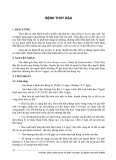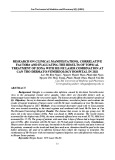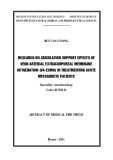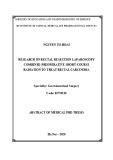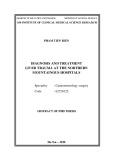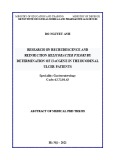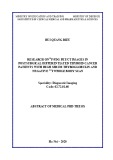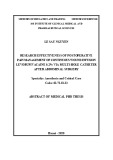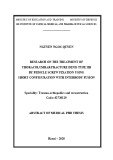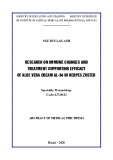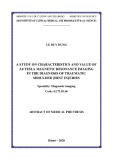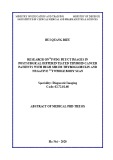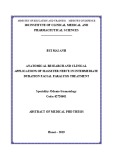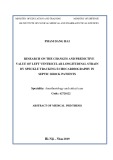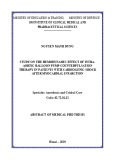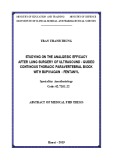M INISTRY OF EDUCATION AND TRAINING M INISTRY OF DEFENCE
108 IN STITU TE OF C LINI C A L MEDI C A L AN D P HA R MAC EU TI CA L SCI EN C ES
------------------------------------------------- NGUYEN LAN ANH
RESEARCH ON IMMUNE CHANGES AND
TREATMENT SUPPORTING EFFICACY
OF ALOE VERA CREAM AL-04 IN HERPES ZOSTER
Speciality: Dermatology
Code: 62720152
ABSTRACT OF MEDICAL PHD THESIS
Hanoi – 2020
THE THESIS WAS DONE IN: 108 INSTITUTE OF CLINICAL MEDICA L AND PHA RMACEUTICAL SCIENCES
Supervisor:
1. Ass.Prof. PhD. Dang Van Em 2. PhD. Bui Thi Van
Reviewer:
1. 2. 3.
This thesis will be presented at Institute Council at: 108 Institute of Clinical Medical and Pharmaceutical Sciences Day Month Year The thesis can be found at:
Institute of Clinica l Medica l and 1. National Library of Vietnam 2. Library of 108 Pharmaceutical Sciences
3. Central Institute for Medical Science Infomation and Tecnology
1
INTRODUCTION
Herpes zoster–HZ (Shingles) is a common disease among
viralskin diseases, caused by Varicella Zoster Virus.
DiagnosingHZ is based on the clinical symtoms: vesicles,
blisters that arise in c lusters from the erythematous plaques along the peripheral nerve, usually in one side of the body.
HZ is associated with cellular immunodeficiency states,
decline in the number and proportion of TCD4, CD16 + 56. The concentration of IgA, IgG and IgM ascends, peaks in week 2-3, then
descends.
Aloe vera cream AL-04
that contains Anthraquinon whichinhibits activity of Herpes simplex virustype 1 and 2,
Acemannan has immunomodulation function and
Glucomannanhelpshealing woundsrapidly. In order to examine the the efficacy of aloe treating herpes zoster, we study in
thesis:“Researchon immune changes and treament supporting
efficacy of aloe vera cream AL-04 in herpes zoster"with following purposes:
1. Surveyingrelated factors, clinical characteristics of herpes
zoster thatareinpatient treated in the Department of Allergy- Dermatology, Central Military Hospital 108 from 6/2015-
6/2018.
2. Determinatingchanges in humoral immunity (IgA, IgG and IgM) and cellular immunity (TCD3, TCD4, TCD8, CD19
and CD16+56) in blood of patients with herpes zoster before
and after treatment.
3. Evaluating the effectiveness of using aloe vera cream as
supporting treatments in herpes zoster.
2
Chapter 1
OVERVIEW 1.1. Herpes zoster: Etiology, pathogenesis, clinical presentations
1.1.1 Factors associated with herpes zoster
-Prevalence: about 10-20% of adults are likely to suffer from HZ in their lives, whereas this rate in people over 85 of age is 50%.
-Age: can occur at any age, but most likelytopeople in older age
groups, especially to those who are above 50 years old. -Gender: The risk ofthe disease is higher to females, especially in
elderly patients.
-Immune status: People with immunodeficiency face a 20-100 times higher risk of suffering than normal people.
1.1.2. Etiology
Varicella Zoster Virus (VZV) is a member of the Alpha herpes virus, with a diameter of 80-120 nm, molecular weight 80000.
The double strainded DNA genome is covered by a 20-sided cube,
followed by the capsid, a protein tergument seperates the capsid from the lipid envelope.
1.1.3. Pathogenesis
The reactivated VZV in sensory ganglia causes herpes zoster. Virus multiplies and spreads within the ganglion, causing
neuronal necrosis and intense inflammation. Then, the virus moves
centrifugallyalong the sensory nerves, causing intense neuritis andinflammation to the skin, causing skin damages.
-Pathogenesis of pain: peripheral nerves and ganglion
neuritisdamaged triggers pain. 1.1.4. Clinical presentations
3
-Basic lesions: erythematous plaques with vesicles and
blistersthat arise in clusters along the peripheral nerve, stop in the middle of the body.
- Functional symptoms: pain is varied, with various types of
pain.
-Complications: includingcutaneous complications,
neurological complications (postherpetic neuralgia, cranial nerve
encephalitis), vascular pathology, palsies,
damage, nerve myelopathy, retinal necrosis.
1.1.5. Subclinical features
-Tzanck cell smear, PCR, direct immunofluorescent assay, viral culture, histopathology, serologic test,quantitating test of IgA,
IgG and IgM.
1.2. Immune changes 1.2.1. Cellular immunity changes
Herpes zoster is associated with a decline in cellular
immunity response, especially the number of TCD4. However, VZV also causes TCD4 cells to raise the production of activated cytokines
TCD8, increase the number of TCD8 to destroy virus infected cells.
CD19 is present in all B lymphocytes. There have been no research in our country and in the world about changes of CD19 in
shingles.
Natural killer cells secreted IFN-γ, TNF-α, the interleukin (IL-10) very quickly and efficiently, play an important role in the
immune response from the very early stage. First response of the host
body to VZV is the reaction of NK cells. 1.2.2. Humoral immunity changes
4
IgG begins to grow rapidly from the 5th day, reaches the
highest from the 9th day to the 23rd day and then began to decline. IgA also begins to rise from the 5th day, peaksafter 6-23 days, then
descents. IgM is discovered from the 9th day, but only exists briefly.
1.3. Treatment -Systemic treatments: antiviral drugs, analgesics, tricyclic
antidepressants, antiepilepsy, oxycodone, glucocorticoid,
antihistamines, antibiotics. -Topical treatment: Acyclovir cream, antiseptic solutions: Yarish,
Jarish, reservoir.
-Medicines with plant origin that are effective on zoster: Capsaicin, licorice, honey.
1.4. Treatment efficacy of aloe cream AL-04
-Some of the main mechanisms of aloe vera: healing woundrapidly, anti-infection, anti-inflammatory, immunomodulation, antibacterial...
-Some primaryeffects of aloe vera in zoster: local
immunomodulation, anti-inflammatory, analgesic, antiseptic. -Some research of aloe vera cream in the treatment of viral skin
diseases: treatment of herpes simplex type 1 and 2.
5
Chapter 2
SUBJECTS AND METHODS
2.1. Subjects and material research
2.1.1. Research subjects
405 patients diagnosed withHZthat are treated as inpatient in the department of Allergy- Dermatology, Central Military Hospital
108.
-Diagnostic criteria:
+ Clinical symptoms: vesicles, blisters that arise in clusters
from the erythematous plaque along the peripheral nerve, on one side
of the body.
+ Functional symptoms: pain in various levels.
+Other symptoms: fever, swollen local lymph nodes,
insomnia, peripheral nerve damage. -Patient se lection criteria:
Purpose 1: Surveying involved factors, clinical characteristics of
herpes zoster:all HZ patients of all ages, both genders, agreed to participate in the study.
Purpose 2: Determining changes in humoral and cellular immunity
in blood of HZpatients before and after treatment.
+ Group of herpes zoster (including research group-RGand
control group-CG of purpose 3): 62 patients with HZ onset ≤ 5 days
(from skin lesions); age ≥ 18; did not use any drugs previously such from as corticoid, zoster treatment drugs,are not suffering
immunodeficiency diseases or HIV/AIDS; follow the treatment
process and agreed to participate in the study. + The control group (the healthy people): 30 healthy people
who havedone health examination in Central Military Hospital 108,
6
withthe same age and gender with the patients group.
Purpose 3: Evaluating the effectiveness of supporting treatment of aloe vera cream AL-04 in herpes zoster .
+ Patients with HZ onset ≤ 5 days; age ≥ 18; did not use any
of drugs previously such as corticoid, zoster treatment drugs,are not no suffering immunodeficiency diseasesorHIV/AIDS; from
ulcerative and necrotic les ions, no contraindications to drugs that
used in the research; agreed to participate in the study; follow the treatment process.
The patient is randomly divided into 2 groups: The research
group (RG): 32 patients and the control group (CG): 30 patients. - Exclusion criterias:
Purpose 1: The patient does not agree to participate in the study.
Purpose 2: Patientsbelow 18 years old, onset of the disease over 5 days (from the date of the lesions), have immunodeficiency disease,
have contraindication for drugs that used in the research, do not
agree to participate in the research or not follow the right treatment procedure.
Purpose 3: As purpose 2.
2.1.2. Research materials -Aloe vera cream Al-04.
-Ayclovir cream 5% from Korea.
-Chemicals for examination: Becton-Dickinson's reagents, flow cell counting solutions on the
Callibur FASC, PBS buffer, mono clone antibodies CD3-ECD, CD4-
PE, CD8-FITC, CD45-PC5, cell counting solution on the ADVIA 2120i, erythrocyte separatial solution.
-Tes t machines:
7
-Autochemistry machine ADVIA 2120i, machine FASC Callibur,
AU 640. 2.2. Research methodology
2.2.1. Study des ign
-Purpose 1: cross-sectional, prospectivestudy. -Purpose 2: cross-sectional, prospective, comparativestudy.
-Purpose 3: clinical trials, randomized controlled, comparative and
prospectivestudy. 2.2.2. Study sample size
-Purpose 1: Convenient sample, n = 405 patients.
-Purpose 2: Calculate the sample size according to the WHO’s formula, RG: 62 patients, CG: 30 patients, same age and gender.
-Purpose 3: Calculate the sample size according to the clinical trials
of WHO: RG: 32 patients, CG: 30 patients. The patient is dividedinto 2 groups by parity selecting and same age, sex and disease degree.
2.2.3. Study procedure
-Surve ying involved factors, clinical characteristics of herpes zoster:
Reception of zoster patients, clinical examination, criteria collection
according to the criteria in the studyfile. -Determinating changes in humoral and cellular immunity in
blood of herpes zoster patients before and after treatment:
HZ group (RG group and CG of purpose 3): + Select patients who have suitable standards for the group of
diseases (namely RG: 32 patients and ĐC: 30 patients of target 3).
+ Do the first blood test (before treatment) including: Counting the number of TCD3, TCD4, TCD8, CD19 and CD16 + 56 (according to
each blood sample), quantitative IgA, IgG and IgM.
8
+ Patient receiving treatment for 20 days.
+ Do the second blood test (after treatment) including: Counting the number of TCD3, TCD4, TCD8, CD19 and CD16 + 56 (according
toeach blood sample), quantitative IgA, IgG and IgM.
Healthy group (CG): 30 healthy people chosen in the health examination at Military Central Hospital 108: have the same age and
gender with RG, do the blood test only one time, count the number
of TCD3, TCD4, TCD8, CD19 and CD16 + 56, quantitative IgA IgG and IgM.
-Evaluating the effectiveness of using aloe vera cream AL-04 as
supporting treatments in herpes zoster:62 patients divided into 2 groups:
+ RG: 32 patients.
+ CG: 30 patients with the same age, gender and degree of disease with NNC. Treatment procedure:
-RG: Acyclovir 800mg x 5 tablets/day x 7 days, aloe cream AL-04
apply 2 times/dayin the morning and afternoon until crust is over. -CG: Acyclovir 800mg x 5 tablets/day x 7 days, acyclovir cream
apply 4 times/day until crust is over.
Also both groups take the same drugs: Pregabalin 75mg x 2 tablets/day x 20 days, desloratadin 5 mg x 1 tablet/day x 20 days,
vitamin 3B x 2 tablets/day x 20 days, rotundin 30 mg x 1 tablet/day x 20 days.
Evaluating results: After 20 days with the following criterias: clinical symptoms (basic lesions), pain symptoms, treatment results
(good, quite good, moderate, bad), unexpected effects (redness of the
skin, itching and dryness of the skin). 2.2.4. Techniques use d inthe research
-The rules of hands of Blokhin and Glumov: One patient's hand
9
corresponds to 1% of the body area.
-Likert score
Face expression Intensity of By word (without word) pain
Painless Peaceful expression 0
Least painful Stressful expression 1-2
Rather painful Grimace expression 3-4
Mediun painful Mourning, deploring 5-6
Severe painful Crying 7-8
9-10 Terrible painful Miserably
-Classification of disease degrees:
+ Mild degree: Area of damage: < 1%ofbody area (BA); Likert ≤ 4; No local lymph nodesswollen; no peripheral nerve damage; sleep
disturbance: little; physical condition: no fever, not tired.
+ Medium degree: Area of damage: 1-2% BA; Likert: 5-6; local lymphadenitis: yes or no; no peripheral nerve damage; sleep
discontinuity: little; physical condition: no fever, fatigue or not.
+ Severity degree: lesion ≥ 2% BA; Likert ≥ 7; local lymphadenitis: yes or no; may have peripheral nerve damage; sleep discontinuity;
physical condition: fever or not.
-The techniques of immune and cellular immunity tests: -Count cell TCD3, TCD4, TCD8, CD19, CD16 + 56:
Each patient take 2 ml of venous blood. Countthe cell
number and cell components of peripheral blood with automatic hematology machine ADVIA 2120i. Determination of the number
and proportion of T-lymphocytes by the flow cytometry analysis
technique on Callibur FACS device. For each blood sample, the
10
machine will give 5 immune indexs as the number of TCD3, TCD4,
TCD8, CD19 and CD16 + 56. -Quantitative of Ig (A, G, M): Quantitative Ig in the patient's blood
by immuno turbidity meter.
The patient is taken 2 ml of blood,centrifugal turn 4000 rounds for 5 minutes, separating the serum and automatic analysis on
the AU640 machine.
2.2.5. Study criterias - Purpose 1: Age, gender, time of having disease, time of prodome,
treated drugs; basic lesions, lesion area; pain: according the Likert
score; accompanied symptoms: fever, insomnia, local lymph nodes swollen, nerve damage.
- Purpose 2: Number of TCD3, TCD4, TCD8, CD19, CD16 + 56.;
Quantitative concentrations of IgA, IgG and IgM; Relation between TCDand Ig with clinica symptoms.
- Purpose 3: Crusty time, time of crust over, scar status, pain
symptoms, treatment result assesment, unexpected effects. 2.2.6. Method of res ults evaluation
-Good:skin healedwithout scar; pain: Out of pain, Likert = 0; no
sequela; quality of life: does not affect. -Quite good:skin healedwithout scar; pain: reduced a lot, Likert ≤ 4;
no sequela; quality of life: affected just a little.
-Medium: skin healedwithout scar; pain: reduced a little, Likert = 5- 6; no sequela; quality of life: affected relatively.
-Bad:skinunhealedor heal with bad scars; pain: a lot, Likert ≥ 7;
sequela: may be peripheral nerve damage; quality of life: affectedmany. 2.2.7. Data processment Use the SPSS 18 software with commonly used statistical tests.
11
STUDY DESIGN
12
Chapter 3
RESEARCH RESULTS
3.1. Surveying involved factors, clinical characteristics of herpes
zoster 3.1.1. Involved factors Table 3.2: Distribution by age group (n = 405)
Age group n %
<40 17 4,2
40-49 30 7,4
50-59 88 21,7
60-69 124 30,6
≥70 146 36
Total 405 100
Conclusion: Results at table 3.2 show that the group of
patients over 70 age occupies the highest rate (36%). Clinical characteristics
Table 3.9:Distribution by damaged area (n = 405)
Damage area n %
Head, face, neck 129 31,9
Intercostal 161 39,8
Waist 36 8,9
Leg 47 11,5
Arm 32 7,9
Total 100,0 405 Conclusion: The most common location of the lesion is the intercostal 39.8%, followed by 31.9% head, face and neck.
13
Table 3.10: Basic lesions (n=405)
Basic lesions n %
Erythematous plaque 361 89,1
Vesicles 397 98,1
Pustules 29 7,2
Crusts 59 14,6
1,7 7
Ulcers Conclusion: The most common lesion is vesicles that make up 98.1%, followed by erythematous plaque 89.1%.
Table 3.13: Relative between disease degree and age (n = 405)
Mild Medium Severe Dise ase degree n % n % n %
Age
<40 1 10 7 4,8 9 3,6
40- 49 1 10 11 7,5 18 7,3
50-59 3 30 37 25,2 48 19,4
60- 69 1 10 50 34,0 73 29,4
≥70 4 40 42 28,6 100 40,3
Total 10 100 147 100 248 100
p p<0,05
Conclusion: There is a connection between disease degree and age, with p< 0.05, the higher age, the heavier the shingles.
14
Table 3.15: Relation between disease degree and damaged area (n = 405)
Dise ase degree Mild Medium Severe
n % n % n % Damaged area
1% 6 60 92 62,6 77 31,0
2% 2 20 47 32 95 38,3
≥ 3% 2 20 8 5,4 76 30,3
Total 10 100 147 100 248 100
p <0,01
Conclusion: The percentage of mild and medium patients in group with 1% damaged area is lowest, the incidence of severe
patients in group 2% damaged area is highest, statistically significant
difference, with p< 0.01. 3.2. Immunity changes in HZ
3.2.2. Cellular immunity changes in HZ
TCD between zoster group and healthy group Table 3.18: Comparison of the TCD cell count of 2 groups
p TCD Zos ter group (n=62) Healthy group (n=30)
X ± SD X ± SD
TCD3 1230,9 ± 670,8 1334,4±384,7 >0,05
TCD4 669,5 ± 355,5 682,9±240,0 >0,05
TCD8 477,8 ± 330,1 527,5±255,4 >0,05
CD19 265,5 ± 180,1 261,8±201,3 >0,05
<0,05 CD16+56 252,7 ± 199,7 458,3±329,3
Conclusion: CD16 + 56 of the research group is markedly
reduced compared to the healthy group with p < 0.05.
15
Comparision of cellular immunity changes between research group
and control group
Table 3.25: Comparison of cell immunity of research group before
and after treament (n = 32)
Time Before After p
TCD treatment treatment
TCD3 1115,7 ± 519,1 1356,8 ± 511,1 <0,05
TCD4 624,9 ± 311,7 708,8 ± 286,2 <0,05
TCD8 419,5 ± 247,6 544,3 ± 271,2 <0,05
CD19 243,3 ± 158,3 294,3 ± 159,2 <0,05
CD16+56 176,4 ± 124,0 246,4 ± 183,5 <0,05
Conclusion: The number of immune cells after treatment is
higher than before, statistically significant difference, both with p< 0.05.
3.2.3. Humoral immunity changes
3.2.3.1. Comparision of Ig of zoster group and healthy group
Table 3.27: Comparision of concentration of Ig of 2 groups
Group p
Igs Zos ter group (n=62) Healthy group (n=30)
IgA 2,52 ± 0,96 2,53 ± 1,13 >0,05
IgG 13,57 ± 3,95 14,15 ± 2,72 >0,05
IgM 0,90 ± 0,38 0,96 ± 0,39 >0,05
Concusion: Ig A, IgG, IgM concentrations of zoster group have changed compared to the healthygroup, but the difference is not
statistically significant, with p > 0.05.
3.3. The effectiveness of using aloe vera cream AL-04 as supporting treatments in herpes zoster
16
Comparision of treatment result between 2 groups
Table 3.55: Comparision of the healing skin effect of 2 groups
Time of healed skin RG CG p
(days) (n=32) (n=30)
Mean time of to be crusted 4,8 ± 2,0 5,7 ± 2,2 >0,05
(X±SD)
Mean time of desquamation 8,1 ± 2,2 9,7 ± 2,3 <0,01
(X±SD)
Conclusion: The time to be crusted of 2 groups is equally
equal, with p > 0.05. But the mean timeof desquamation of research group was lower than the control group, statistically significant
difference, with p< 0.01.
Table 3.56: Comparision of pain relief according to Likert scores between 2 groups
Group p
Res ult RG (n=32) CG (n=30)
Likert before treated 6,59 ± 0,95 6,63 ± 1,03 >0,05
(4-8) (5-8)
Likert after treated 2,47 ± 1,27 3,40 ± 1,87 <0,05
(0-5) (0-7)
Likert scores reduced 4,09 ± 1,38 3,23 ± 1,91 <0,05
% Likert reduced 61,04 ±18,90 48,61 ± 28,58 <0,05
Conclusion: The Likert score after treatment in the research
group decreased better than the control group with p < 0.05.
17
Table 3.58: Comparision of general results between 2 groups
Res ult RG (n=32) CG (n=30) p
n n % %
Good 3 2 6,7 9,4
Rather good 28 87,5 <0,05 18 60,0
Medium 1 7 23,3 3,1
Bad 0 3 10,0 0
Conclusion: After 20 days of treatment, the results of
research group was better than the control group, with p< 0.05.
Table 3.59: Comparision of unexpected effects between 2 groups
Unexpected effects RG (n=32) CG (n=30) p
n (%) n (%)
Redness 0 0 0 0 >0,05
Itching 0 0 1 3,3
Dryness 0 0 0 0
Conclusion: Unexpected effects of 2 groups were not
difference, with p > 0.05.
18
Chapter 4
DISCUSSION
4.1. Related factors and clinical characteristics of zoster
Herpes zoster accounts for 8.92% of the total number of
inpatient skin diseases in Allergy- dermatology (table 3.1), higher the outcome of Tran The Cong, because of my research had done in
Allergy- dermatollogy of Central Military Hospital 108, where the
average age of patients were higher, so the incidence of shingles will be higher too.
4.1.1. Related factors
Zoster may happen at any age, but as a result,the older people are, the higher the risk of the disease is,due to its association with
cellular immunodeficiency. In our research, zosterwere most common
at ages over 70 (36%) (table 3.2), then the 60-69-year-old group (30.6%), similar to Dang Van Em's research, higher than Tran The
Cong and Nguyen Thi Thu Hoai at the Department of Dermatology,
Military Hospital103, because of by the bigger number ofolder patients.
The table 3.9 shows the most common damaged area was
intercostal (39.8%), followed by the head, face, neck (31.9%) and waist (8.9%). This results in accordance with the research of the
authors in the region and lower than the authors in the world, perhaps
due to the differences in georaphy, race and time.
The basic lesions were mainly blisters (98.1%), followed by a
erythematous plaques (89.1%). In fact, on the same patient may
hadvarious types of lesions at the same time.
Table 3.13 showed that the higher the age, the greater incidence
of the severe disease, the severe patients in the group of 70 years of age
19
occupy the highest rate (40.3%), similar to the results of Doan Anh
Tuan and Dang Van Em.
The lesion area was associated with the degree of disease, the
smaller the area is, theminor theseverity of diseases is. This in
accordance with clinical practice is the wider the area of damage, the more patients have a feeling of external painess, in addition to pain
caused by nerve damaged, so the Likert score is usually higher.
4.2.2. Cellular immunity changes
From the table 3.18, we may notice that no difference in the
number of immune cells TCD3, TCD4, TCD8 and CD19. Only the
number of CD16 + 56 in the zoster group was lower than that of the healthy group.
The T-lymphocytes subsets in the peripheral blood reflect
condition of the body's immune responses. These cells’ changes will cause immune system disorders, increase the risk of infectious
diseases.
TCD3 is the first cell that reflects this change. TCD4 has an importantrole in sending signals to other immune cells to destroy
infected cells. TCD4 keeps the virus in the ganglions and prevents
them from re-activating. In addition, they also produce cytokines. If TCD4 decreases, human will face a high risk of infections.
TCD8 works together with TCD4 to destroy VZV in the latent
time as well as the reactivation phase by disclosing the intermediate proteins revealed on VZV, limiting the replication and sreading of
the virus, and preventing them from re-activation. The opinion
onTCD8 's role in zoster of the world's authors is not yet agreed. Our research had not seen a change in comparison to the healthy group.
20
There is still no research in the world in the CD19’s role in HZ.
Our research had not seen this relation yet, the number of CD19 in the HZ patient group and the healthy group had no difference.
Natural killer cells secreted cytokines such as IFN-γ, TNF-α, IL-
1, IL-3. They produce fast and effective cytokines as soon as they are stimulated, which play an important role in the immune response
from the early stages. Our results at table 3.18 showed that the
number of natural killer cells in HZ group was lower than the healthy group, and after the 20-day treatment, the number of natural killer
cells increased markedly (table 3.19), suitable for author James
Barton and T. Ihara.
In the group of HZ patients were treated by aloe vera (RG),
table 3.25 showed that the number of all immune cells after treatment
was elevated compared to the pre-treatment. While in the group of patients were treated by acyclovir cream (CG) at table 3.26, only
CD16 + 56 increased. From this result, we can see that the patient
group of aloe vera was more likely to recover from the cellular immune response.
4.2.3. Humoral immunity changes
The result at table 3.27 showed
that IgA, IgG, IgM concentrations of HZ group had changed compared to the healthy
group, but the differences are not statistically significant, both with p
> 0.05, similar to the results of Tamar , Liwei and Choon Kwan Kim, other than Cradock-Watson, and Seong Won Min, due to our tests
only quantificate the total Ig, but not theVZV specific Ig, so the
results will not be as accurate as those of the authors. 4.3.2.3. Comparision to the treatment result of 2 groups
21
The duration of the desquamation of research group was lower
than the control group, indicated that the aloe cream has a better healing skin-effect than acyclovir cream (table 3.55), because of the
AL-04 cream has antiviral, antibacterial and anti-inflammatory
activity, and upregulate synthesis of collagen and fibroblasts. For these reasons, using AL-04 cream in treatment HZ will help reducing
healing time better than the group of acyclovir.
After 20 days of treatment, the Likert score decreased and the percentage reduction of Likert in the research group was higher than
the control group (table 3.56). So that, the AL-04 treament group has
a better analgesic effect than the group of acyclovir cream. As stated above, this analgesic effect is caused by inhibiting the synthesis of
mediated chemicals such as prostaglandins, histamine, bradikynin,
inhibiting the release of leucotrien from mast cells, reducing the synthesis of thromboxane A2 in the area of lesions. Acyclovir does
not have this great effect, the analgesic effects in the control group
will be inferior.
General assessment after 20 days of treatment, good and quite
good in the research group (96.9%) were higher than the control
group (66.7%), statistically significant difference (table 3.58). Thus, the AL-04 cream treatment group has a better result than the ayclovir
group.
Aloe vera has many components that help to heal wounds, there is also an analgesic effect. Consequently, it has a better therapeutic
outcome than acyclovir cream, which only has a virus inhibitory
activity.
22
In both groups, the incidence of unexpected effects is equivalent
(table 3.59). There is no case have to stop applying cream because of this unexpected effects.
Thus, AL-04 cream has no side effects virtually, the person is
thiscream. not experiencing any discomfort when applying Moreover, the drug is easier to use than acyclovir cream, aplly 2
times a day instead of 4 times a day.
CONCLUSION
1. Related factors and clinical characteristics of herpes zoster
1.1. Related factors
HZ accounts for 8.92% of all inpatient skin diseases.
The disease is encountered at any age, in which the group
over 70of age occupies the most (36%), percentage of male patients(59,3%) is higher than female’s (40.7%). Common prodomal
symptoms are: soreness (37.8%) in the area is about to suffer
(53.1%).
The incidence of patients with combined disease is:
autoimmune disease: 1%, cancer: 4.7%, diabetes: 12.1%,
hypertension: 9.6%, cardiovascular disease: 8.6%, lipid metabolism disorder: 25.9%.1.
1.2. Clinical characteristics of herpes zoster
The most common damagedarea is the intercostal (39.8%). The most common symptom is soreness (37.8%). The most
common basic les ion is blisters (98.1%) and erythematous plaques
(89.1%). 83.2% of patients suffer from insomnia.
The degree of disease is associated with the area of the
lesion and age of patients: the greater the area of damage is and the
23
older the patients are, the greater the severe of the disease is.
2. Immune changes in herpes zoster 2.1. Cellular immunity changes
-In herpes zoster, the number of TCD3, TCD8 and CD16 +
56 decreases, that increases after treatment. CD16 + 56 drops more than healthy people.
-Have not seen the change of TCD4 and CD19.
-Have not seen the relationship between cellular
immunityand age of patients, damaged area and degree of disease.
2.2. Humoral immunity changes
-Have not seen humoral immunity changes in herpes zoster. -Have not seen the relationship between humoral immunity
and age of patients, degree of disease as well damaged area.
3. Supporting treatment efficacy of AL-04 cream in herpes zoster 3.1. Clinical efficacy
-Healing skin effects: mean time of being crusted: is 4.8 ±
2.0 days, equivalent to the control group.
Mean time of desquamation is 8.1 ± 2.2 days, less than that
of the control group. The wider the lesion, the longer time of
desquamation.
The lesion is mostly left with a flat scar of 93.8%, 9.4%
concave scar, equivalent to control group.
-Analgesic effect: After treatment, the Likert score decreases
from 6.56 to 2.47, which is better than the control group.
-Immunebooster: The number of immune cells after
treatment is increased more than before treatment, more clearly than the control group.
-Result of research group: Good 9.4%, quite good 87.5%,
24
medium 3.1%, bad 0%. This results in higher than the control group.
The result of treatment is not related to the age of patients,
degree of disease and damaged area.
3.2. Unexpected effects
There is no case having any unexpected effects caused by the
drug.
PROPOSALS
1. Encourage using AL-04 cream in treating herpes zoster
because of its simple use, good efficacy and no unexpected effects.
2. It is necessary to do CD16 + 56 tests with larger sample
sizes, to assess the role of natural killer cells in herpes zoster.
3. Further examination of the specific immunoglobulin with
VZV to assess the role of this antibodies in herpes zoster.
LIST OF PUBLISHED ARTICLE RELATING TO THESIS
1. Nguyen Lan Anh, Dang Van Em (2016), “Research on
epidermiological and clinical characteristics of herpes zoster at Central Military Hospital 108”, Journal of 108 – Clinical
Medicine and Pharmacy , 11(9), pp. 294-299.
2. Nguyen Lan Anh, Dang Van Em (2018), “Research on the suppoting treatment effectiveness of aloe vera creamAl-04 in
herpes zoster”, Journal of 108 – Clinical Medicine and
Pharmacy, 13(9), pp. 92-97.
3. Nguyen Lan Anh, Dang Van Em (2018), “Research on
immuno changes in herpes zoster”,Journal of 108 – Clinical
Medicine and Pharmacy,13(9), pp. 264-268.


